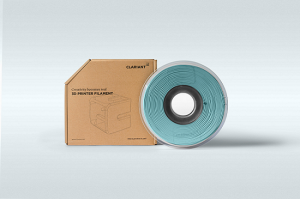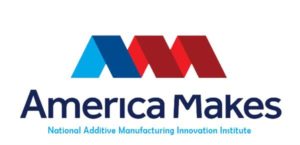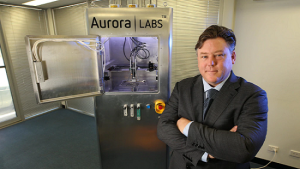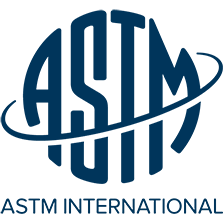We’re starting off with some news about products being displayed at the upcoming formnext in today’s 3D Printing News Briefs, and then moving on to business and research news. Clariant and Xaar have both revealed what they will be showcasing at formnext 2018 in Munich next month. Aurora Metals has announced a new partnership, while Lockheed Martin is the first organization to have an additive manufacturing facility certified to UL 3400 for AM hazards. Finally, America Makes has announced its next Directed Project Opportunity.
Clariant Presenting Industrial 3D Printing Materials at formnext
 This year’s formnext is coming up in just a few short weeks, and companies all over the world are announcing what products they’ll be bringing with them to the show. Specialty chemicals company Clariant will be showcasing its 3D printing materials and solutions for intelligent industrial manufacturing at the event this year, including featured materials like polyamides for small lot production, customer-tailored colorant and additive guidance, and high impact strength materials that offer electrostatic discharge protection for manufacturing aids.
This year’s formnext is coming up in just a few short weeks, and companies all over the world are announcing what products they’ll be bringing with them to the show. Specialty chemicals company Clariant will be showcasing its 3D printing materials and solutions for intelligent industrial manufacturing at the event this year, including featured materials like polyamides for small lot production, customer-tailored colorant and additive guidance, and high impact strength materials that offer electrostatic discharge protection for manufacturing aids.
“OEMs require that 3D printing materials perform at the same level as their injection molded counterparts. This was the significant factor in achieving the acceptance to allow product production with our materials and will continue to be,” said Joanna Marguier, Senior Manager of R&D for Clariant’s 3D printing business. “From the inception of our 3D printing business, Clariant has focused on providing superior 3D printing materials that achieve the customer’s requirements for their specific application. We work closely with them to tailor solutions to meet their needs.”
Marguier will also be outlining the company’s success with flame retardants in a technical presentation at formnext on November 15. formnext runs November 13-16, and you can visit the Clariant team at booth 3.1-H40 in Hall 3.1 at the Messe Frankfurt.
Xaar Showcasing Latest Inkjet Printhead Technology at formnext
 Speaking of formnext, digital inkjet technology Xaar will be exhibiting the latest in inkjet printhead technology at the show. Visitors can learn how the company’s award-winning High Laydown (HL) technology, which allows for the jetting of 3D fluids with high viscosity (at least 55cP), coupled with its partnerships with other industry leaders, can help its customers get ahead in volume 3D printing. Xaar will also be displaying samples that were produced with high viscosity photoresins from BASF 3D Printing Solutions
Speaking of formnext, digital inkjet technology Xaar will be exhibiting the latest in inkjet printhead technology at the show. Visitors can learn how the company’s award-winning High Laydown (HL) technology, which allows for the jetting of 3D fluids with high viscosity (at least 55cP), coupled with its partnerships with other industry leaders, can help its customers get ahead in volume 3D printing. Xaar will also be displaying samples that were produced with high viscosity photoresins from BASF 3D Printing Solutions
“The formnext show is a major global event for the 3D Printing sector and we are excited to be exhibiting our complete printhead portfolio and HL Technology for volume 3D production. We pride ourselves on providing ongoing support to all our customers’ projects – from early fluid evaluation through to commercialisation. That’s why we are welcoming manufacturers and integrators to visit the Xaar stand and discover how our printhead technology can help them introduce new printers quickly and cost-effectively, thereby delivering a true competitive edge and real value to 3D end- users,” said Simon Kirk, Senior Product Manager at Xaar.
You can visit Xaar at formnext at booth A78 in Hall 3.1
Aurora Labs Partnering with Fortescue Metals Group
Australian metal 3D printing Aurora Labs has signed a preliminary non-binding term sheet agreement with fellow Australian company Fortescue Metals Group. The agreement comprises an Industry Partner Program, and Aurora Labs will work with Fortescue to demonstrate the potential for application of its Rapid Manufacturing Technology (RMT) in the mining industry. The terms of the agreement are for an initial 12 months and may be extended by mutual agreement, and Aurora believes that the venture could even progress further to developing technology together in order to lower operation and production costs in the mining industry.
“We’re very excited to sign a preliminary agreement with Fortescue, and pursue the opportunity to apply Aurora’s Rapid Manufacturing Technology to the mining sector,” said David Budge, Aurora Labs’ Managing Director. “Fortescue are an ideal industry partner for us and they are at the forefront of technological advancements in the mining sector.”
Lockheed Martin Certified UL 3400
![]() Top global safety science company UL has announced that it has certified the first additive manufacturing facility to UL 3400, a set of safety guidelines published last year that address the hazards associated with AM facilities. UL issued this prestigious certification to Lockheed Martin, and its 6,775-square-foot Additive Design and Manufacturing Center in Sunnyvale, California. UL 3400, also called the Outline of Investigation for Additive Manufacturing Facility Safety Management, considers the three layers of safety: material, equipment, and the facility itself, and references applicable standards from OSHA, ASTM International, the National Fire Protection Association, and others. UL and its 3400 guideline cover the potential hazards and risk mitigation measures that are required for these facilities to function safely.
Top global safety science company UL has announced that it has certified the first additive manufacturing facility to UL 3400, a set of safety guidelines published last year that address the hazards associated with AM facilities. UL issued this prestigious certification to Lockheed Martin, and its 6,775-square-foot Additive Design and Manufacturing Center in Sunnyvale, California. UL 3400, also called the Outline of Investigation for Additive Manufacturing Facility Safety Management, considers the three layers of safety: material, equipment, and the facility itself, and references applicable standards from OSHA, ASTM International, the National Fire Protection Association, and others. UL and its 3400 guideline cover the potential hazards and risk mitigation measures that are required for these facilities to function safely.
“Employers, employees, local regulators as well as insurance companies who have to underwrite additive manufacturing facilities, were not fully aware of the inherent material and technology risks. Safety is designed rather than built. Not a single standard or statutory guideline was available that specifically focused on additive manufacturing. Other standards and guidelines were developed for conventional manufacturing processes,” explained Balu V. Nair, UL’s Additive Manufacturing Lead Development Engineer and an important player in developing UL 3400. “We decided to address this industry need by developing a set of guidelines with exclusive focus on additive manufacturing.”
America Makes Announces Next Directed Project Opportunity
 This week, America Makes announced its next Directed Project Opportunity, available for its members for AM applied (R&D) projects for Advanced Tools for Rapid Qualification (ATRQ). The goal is to promote and accelerate the development and deployment of cost effective, energy-efficient 3D printing technologies in order to meet defense and/or commercial needs. Approximately $3.9 million should be made available to fund multiple awards, with at least $1.95 million in matching funds from the winning project teams. The technical requirements of the ATRQ Directed Project Opportunity relate to the America Makes Technology Roadmap, as well as the Integrated DoD AM Roadmap.
This week, America Makes announced its next Directed Project Opportunity, available for its members for AM applied (R&D) projects for Advanced Tools for Rapid Qualification (ATRQ). The goal is to promote and accelerate the development and deployment of cost effective, energy-efficient 3D printing technologies in order to meet defense and/or commercial needs. Approximately $3.9 million should be made available to fund multiple awards, with at least $1.95 million in matching funds from the winning project teams. The technical requirements of the ATRQ Directed Project Opportunity relate to the America Makes Technology Roadmap, as well as the Integrated DoD AM Roadmap.
“For our partners at the DoD, the anticipated outcomes of the America Makes ATRQ Directed Project Opportunity are of the utmost importance. The DoD’s need for rapid qualification and certification of AM processes and materials is great,” said Rob Gorham, the Executive Director of America Makes. “These projects will be instrumental in resolving the current deterrents that are hindering the wider adoption and deployment of AM technologies within the DoD and its supply chain.”
Technical topics for the ATRQ Directed Project Opportunity are Surrogate Damage Generation for LPBF Defects, Degradation of Polymer Parts Deployed in Harsh Environments, and Corrosion Mechanisms of LPBF Materials. All Project Concept forms are due no later than 5 pm EST on Wednesday, November 28, 2018. To see all of the technical project requirements, as well as other information about the Directed Project Opportunity like non-disclosure agreements, eligibility, and the proposal process, check out the America Makes website.
Discuss these stories and other 3D printing topics at 3DPrintBoard.com or share your thoughts in the Facebook comments below.









